Search the Special Collections and Archives Portal
Search Results
Howard Hughes being interviewed by reporters in New York, New York, 1946 September 12
Level of Description
File
Archival Collection
Howard Hughes Public Relations Photograph Collection
To request this item in person:
Collection Number: PH-00373
Collection Name: Howard Hughes Public Relations Photograph Collection
Box/Folder: Folder 22
Collection Name: Howard Hughes Public Relations Photograph Collection
Box/Folder: Folder 22
Archival Component
Howard Hughes being interviewed by reporters in New York, New York, 1946 September 12
Level of Description
File
Archival Collection
Howard Hughes Public Relations Photograph Collection
To request this item in person:
Collection Number: PH-00373
Collection Name: Howard Hughes Public Relations Photograph Collection
Box/Folder: Folder 22
Collection Name: Howard Hughes Public Relations Photograph Collection
Box/Folder: Folder 22
Archival Component
Howard Hughes being interviewed by reporters in New York, New York, 1946 September 12
Level of Description
File
Archival Collection
Howard Hughes Public Relations Photograph Collection
To request this item in person:
Collection Number: PH-00373
Collection Name: Howard Hughes Public Relations Photograph Collection
Box/Folder: Folder 22
Collection Name: Howard Hughes Public Relations Photograph Collection
Box/Folder: Folder 22
Archival Component
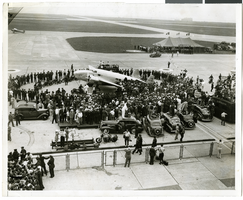
Photograph of crowds at Floyd Bennett Airfield, New York, July 1938
Date
1938-07-14
Archival Collection
Description
The black and white view of Howard Hughes' Lockheed 14 aircraft after performing its final landing on the Round the World flight at Floyd Bennett Airport, New York. Description printed on back of photograph: "General view of welcoming ceremony. 7/14/1938"
Image
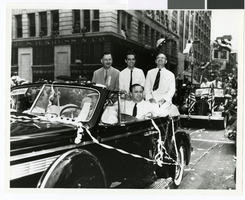
Photograph of Howard Hughes in a parade, Houston, Texas, July 30, 1938
Date
1938-07-30
Archival Collection
Description
Howard Hughes (center sitting up in car) in a parade in Houston, Texas in 1938.
Image
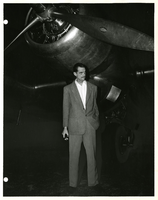
Photograph of Howard Hughes standing near Douglas DC-3, New York, 1947
Date
1947
Archival Collection
Description
Howard Hughes standing under the propeller of a Douglas DC-3.
Image
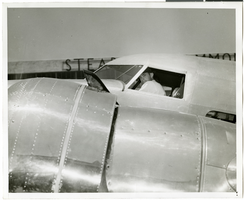
Photograph of Howard Hughes in the Lockheed 14, Los Angeles, California, July 4, 1938
Date
1938-07-04
Archival Collection
Description
Howard Hughes in the Lockheed 14 in Los Angeles, California. Typed on a piece of paper attached to the image: "Howard Hughes off on first leaf of flight to Paris. Los Angeles, Cal. -- Howard Hughes, Millionaire oil man and speed flyer, at the controls of his huge Lockheed "Flying Laboratory" as it took off from here for its leisurely flight to New York, from where Hughes and his crew will fly to Paris and perhaps around the world. 7/4/1938 Credit line (ACME)."
Image
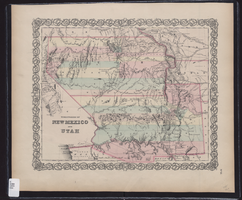
Map showing the territories of New Mexico and Utah, 1855
Date
1855
Description
'Entered according to Act of Congress in the year 1855 by J.H. Colton & Co. in the Clerk's Office of the Dist. Court of the U.S. for the South'n. Dist. of New York.' Scale [ca. 1:4,752,000. 1 in. to approx. 75 miles] (W 120°--W 102°/N 43°--N 32°). Shows natural features, and populated places, wagon route, proposed railroad routes and explorers' routes. Relief shown by hachures. Prime meridians: Greenwich and Washington.Hand colored. Atlas p. number in lower-right margin: 51. Decorative border. J.H. Colton & Co.
Image
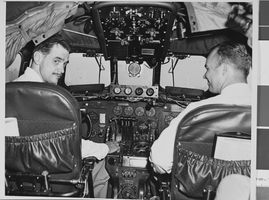
Photograph of Howard Hughes installing radar, Culver City, California, May 03, 1947
Date
1947-05-03
Archival Collection
Description
Description given with photo: "Hughes Pilots Radar-Equipped Plane Culver City, Calif. -- First passenger plane equipped with radar is flown in demonstration May 1st by Howard Hughes (left) and co-pilot R.C. Loomis over Culver City. Pilots using this equipment will be warned of approaching obstacles by lights flashing on radar panel. Two lights (lefts) with 2,000-foot range, are used to guarantee clearance over mountains; two lights (right) with 500-foot range, are a safety device for approaches and landings. Either set of lights warns against approaching aircraft. Trans-World Airline plans to install radar on its passenger planes. Credit (ACME) 5-3-47."
Image
Howard Hughes receives congratulations from New York Mayor Fiorello La Guardia at Floyd Bennett Airport in Brooklyn, New York; also featured is Grover Whalen, 1938 July 12
Level of Description
File
Archival Collection
Howard Hughes Professional and Aeronautical Photographs
To request this item in person:
Collection Number: PH-00321
Collection Name: Howard Hughes Professional and Aeronautical Photographs
Box/Folder: Folder 06
Collection Name: Howard Hughes Professional and Aeronautical Photographs
Box/Folder: Folder 06
Archival Component
Pagination
Refine my results
Content Type
Creator or Contributor
Subject
Archival Collection
Digital Project
Resource Type
Year
Material Type
Place
Language
Records Classification
